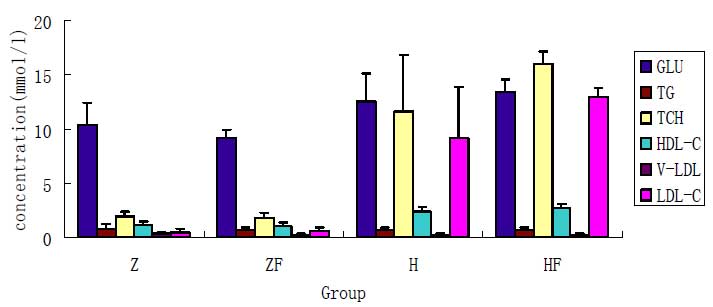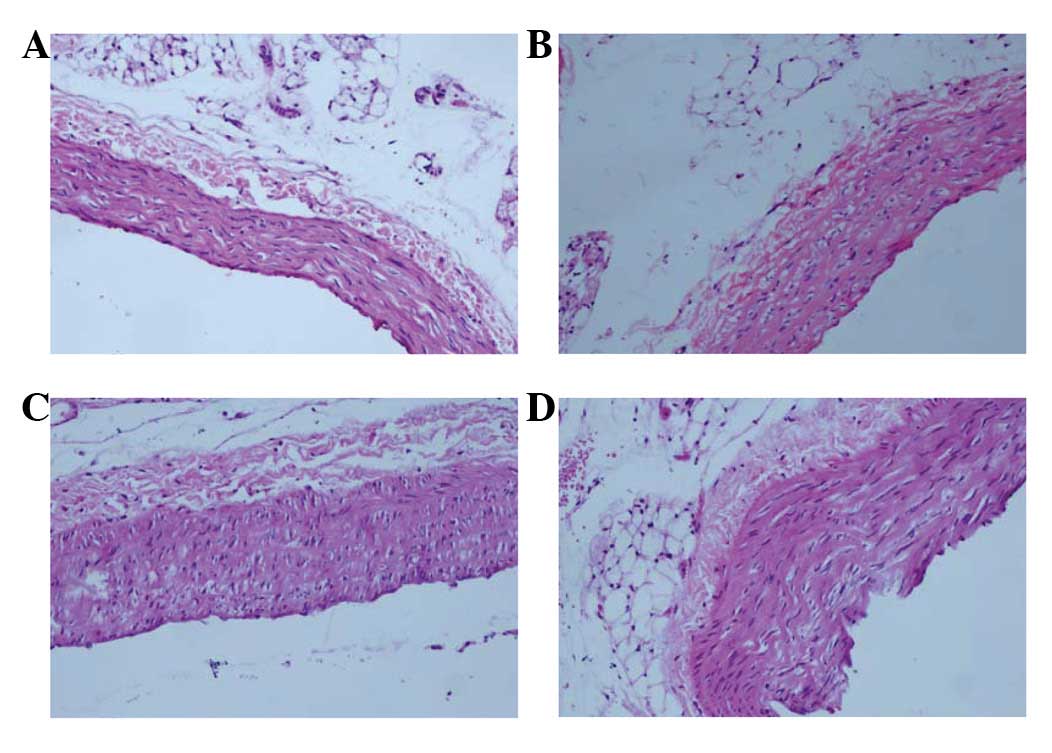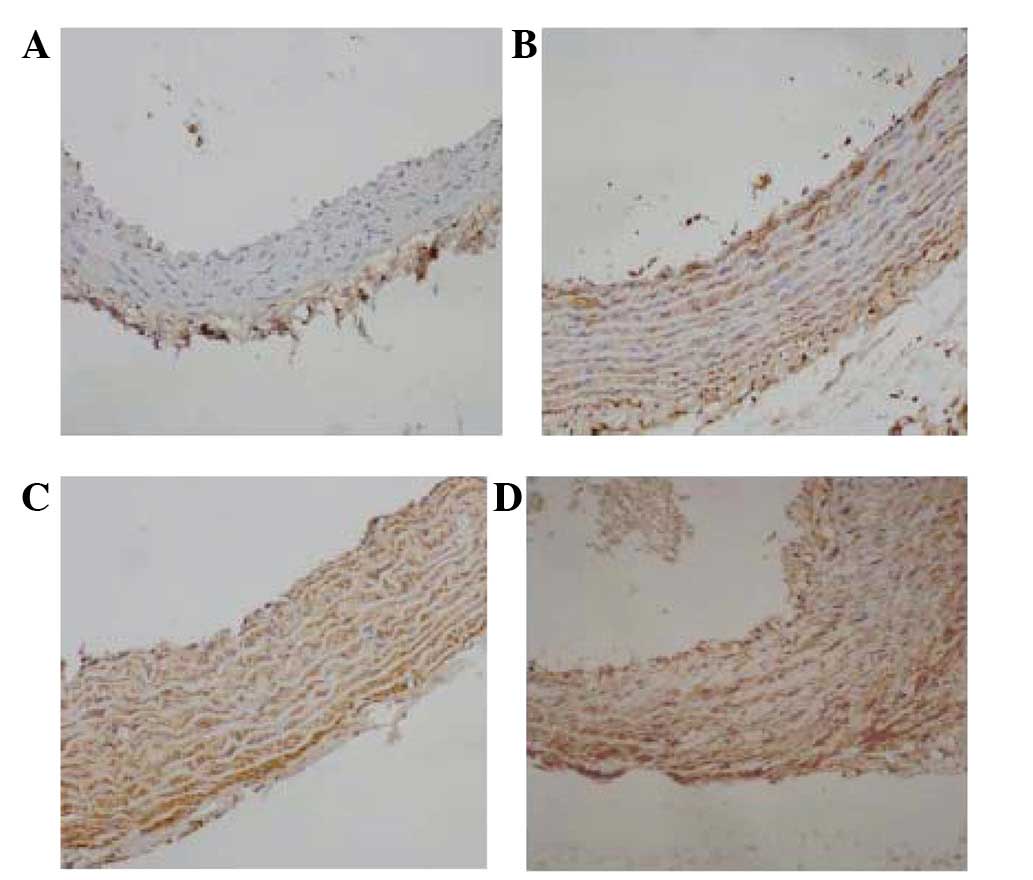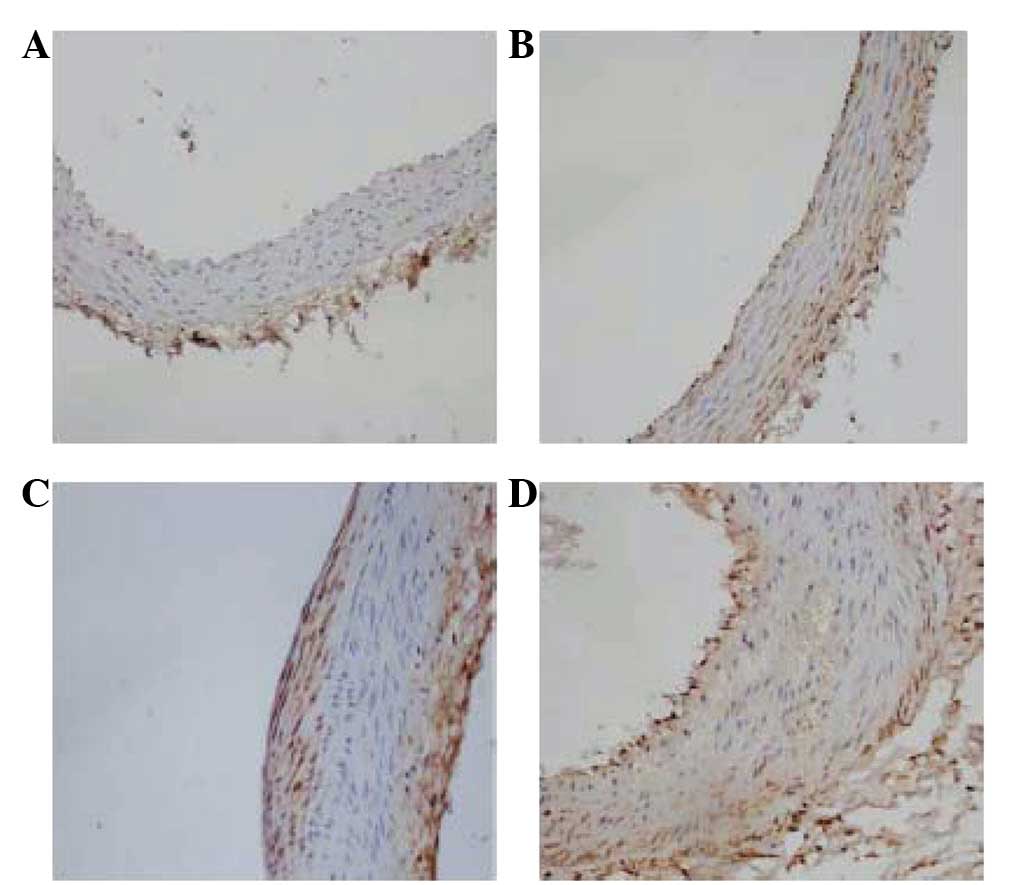|
1.
|
Burger PC and Wagner DD: Platelet
P-selectin facilitates athero-sclerotic lesion development. Blood.
101:2661–2666. 2003. View Article : Google Scholar : PubMed/NCBI
|
|
2.
|
Murray CJ and Lopez AD: Global mortality,
disability, and the contribution of risk factors: Global Burden of
Disease Study. Lancet. 349:1436–1442. 1997. View Article : Google Scholar : PubMed/NCBI
|
|
3.
|
Libby P: Inflammation in atherosclerosis.
Nature. 420:868–874. 2002. View Article : Google Scholar : PubMed/NCBI
|
|
4.
|
Hu MY, Li YL, Jiang CH, Liu ZQ, Qu SL and
Huang YM: Comparison of lycopene and fluvastatin effects on
atherosclerosis induced by a high-fat diet in rabbits. Nutrition.
24:1030–1038. 2008. View Article : Google Scholar : PubMed/NCBI
|
|
5.
|
Lusis AJ: Atherosclerosis. Nature.
407:233–241. 2000. View
Article : Google Scholar : PubMed/NCBI
|
|
6.
|
Papageorgiou N, Tousoulis D, Siasos G and
Stefanadis C: Is fibrinogen a marker of inflammation in coronary
artery disease? Hellenic J Cardiol. 51:1–9. 2010.PubMed/NCBI
|
|
7.
|
Yang H, Lang S, Zhai Z, Li L, Kahr WH,
Chen P, Brkić J, Spring CM, Flick MJ, Degen JL, Freedman J and Ni
H: Fibrinogen is required for maintenance of platelet intracellular
and cell-surface P-selectin expression. Blood. 114:425–436. 2009.
View Article : Google Scholar : PubMed/NCBI
|
|
8.
|
Zhai Z, Wu J, Xu X, Ding K, Ni R, Hu W,
Sun Z and Ni H: Fibrinogen controls human platelet fibronectin
internalization and cell-surface retention. J Throm Haemost.
5:1740–1746. 2007. View Article : Google Scholar : PubMed/NCBI
|
|
9.
|
Li X and Cong H: Platelet-derived
microparticles and the potential of glycoprotein IIb/IIIa
antagonists in treating acute coronary syndrome. Tex Heart Inst J.
36:134–139. 2009.PubMed/NCBI
|
|
10.
|
Eriksson AC, Jonasson L, Lindahl TL,
Hedbäck B and Whiss PA: Static platelet adhesion, flow cytometry
and serum TXB2 levels for monitoring platelet inhibiting treatment
with ASA and clopidogrel in coronary artery disease: a randomised
cross-over study. J Transl Med. 7:42–56. 2009. View Article : Google Scholar
|
|
11.
|
de Moerloose P and Neerman-Arbez M:
Congenital fibrinogen disorders. Semin Thromb Hemost. 35:356–366.
2009.
|
|
12.
|
de Moerloose P, Boehlen F and
Neerman-Arbez M: Fibrinogen and the risk of thrombosis. Semin
Thromb Hemost. 36:7–17. 2010.
|
|
13.
|
Duga S, Asselta R, Santagostino E, Zeinali
S, Simonic T, Malcorati M, Mannucci PM and Tenchini ML: Missense
mutations in the human beta fibrinogen gene cause congenital
afibrinogenemia by impairing fibrinogen secretion. Blood.
95:1336–1341. 2000.PubMed/NCBI
|
|
14.
|
Green D, Foiles N, Chan C, Schreiner PJ
and Liu K: Elevated fibrinogen levels and subsequent subclinical
atherosclerosis: the CARDIA Study. Atherosclerosis. 202:623–631.
2009. View Article : Google Scholar : PubMed/NCBI
|
|
15.
|
Grebe MT, Luu B, Sedding D, Heidt MC,
Kemkes-Matthes B, Schaefer CA, Tillmanns HH and Gündüz D:
Fibrinogen promotes early atherosclerotic changes of the carotid
artery in young, healthy adults. J Atheroscler Thromb.
17:1003–1008. 2010. View
Article : Google Scholar : PubMed/NCBI
|
|
16.
|
Lepedda AJ, Cigliano A, Cherchi GM, et al:
A proteomic approach to differentiate histologically classified
stable and unstable plaques from human carotid arteries.
Atherosclerosis. 203:112–118. 2009. View Article : Google Scholar : PubMed/NCBI
|
|
17.
|
Kannel WB: Overview of hemostatic factors
involved in atherosclerotic cardiovascular disease. Lipids.
40:1215–1220. 2005. View Article : Google Scholar : PubMed/NCBI
|
|
18.
|
Koenig W: Fibrin(ogen) in cardiovascular
disease: an update. Thromb Haemost. 89:601–609. 2003.PubMed/NCBI
|
|
19.
|
Retzinger GS, DeAnglis AP and Patuto SJ:
Adsorption of fibrinogen to droplets of liquid hydrophobic phases.
Functionality of the bound protein and biological implications.
Arterioscler Thromb Vasc Biol. 18:1948–1957. 1998. View Article : Google Scholar : PubMed/NCBI
|
|
20.
|
Rabbani LE and Loscalzo J: Recent
observations on the role of hemostatic determinants in the
development of the atherothrombotic plaque. Atherosclerosis.
105:1–7. 1994. View Article : Google Scholar : PubMed/NCBI
|
|
21.
|
George JN, Lyons RM and Morgan RK:
Membrane changes associated with platelet activation. Exposure of
actin on the platelet surface after thrombin-induced secretion. J
Clin Invest. 66:1–9. 1980. View Article : Google Scholar
|
|
22.
|
Schwertz H, Zimmerman GA and Weyrich AS:
Fibrinogen selects selectins. Blood. 114:2342009. View Article : Google Scholar
|
|
23.
|
Ley K: The role of selectins in
inflammation and disease. Trends Mol Med. 9:263–268. 2003.
View Article : Google Scholar : PubMed/NCBI
|
|
24.
|
McEver RP: Adhesive interactions of
leukocytes, platelets, and the vessel wall during hemostasis and
inflammation. Thromb Haemost. 86:746–756. 2001.PubMed/NCBI
|
|
25.
|
Dong ZM, Brown AA and Wagner DD: Prominent
role of P-selectin in the development of advanced atherosclerosis
in ApoE-deficient mice. Circulation. 101:2290–2295. 2000.
View Article : Google Scholar : PubMed/NCBI
|
|
26.
|
Collins RG, Velji R, Guevara NV, Hicks MJ,
Chan L and Beaudet AL: P-Selectin or intercellular adhesion
molecule (ICAM)-1 deficiency substantially protects against
atherosclerosis in apolipoprotein E-deficient mice. J Exp Med.
191:189–194. 2000. View Article : Google Scholar : PubMed/NCBI
|
|
27.
|
Graff J, Klinkhardt U, Schini-Kerth VB,
Harder S, Franz N, Bassus S and Kirchmaier CM: Close relationship
between the platelet activation marker CD62 and the granular
release of platelet-derived growth factor. J Pharmacol Exp Ther.
300:952–957. 2002. View Article : Google Scholar : PubMed/NCBI
|
|
28.
|
Koyama H, Maeno T, Fukumoto S, et al:
Platelet P-selectin expression is associated with atherosclerotic
wall thickness in carotid artery in humans. Circulation.
108:524–529. 2003. View Article : Google Scholar : PubMed/NCBI
|
|
29.
|
Libby P, Ridker PM and Hansson GK; Leducq
Transatlantic Network on Atherothrombosis: Inflammation in
atherosclerosis: from pathophysiology to practice. J Am Coll
Cardiol. 54:2129–2138. 2009. View Article : Google Scholar : PubMed/NCBI
|


















